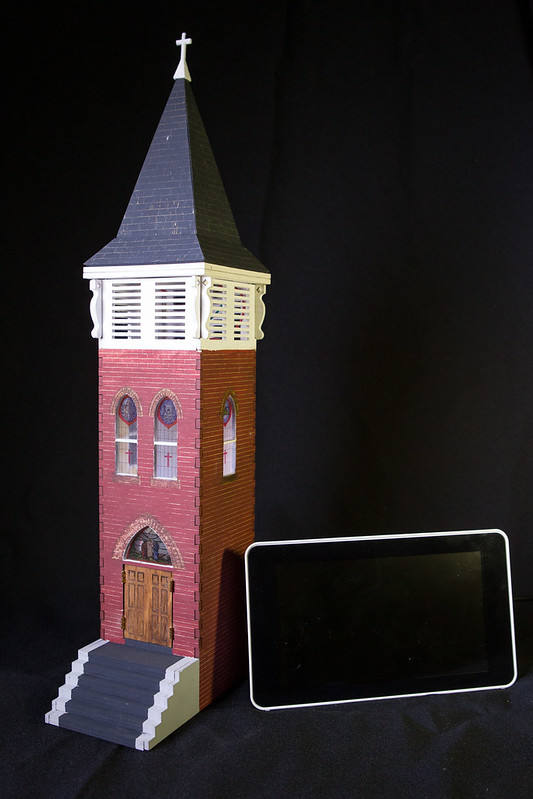Steeple replica for my grandma
My grandma’s church needed a new chimes system to replace their existing old and broken system.
They needed something that would play bell recordings of Methodist hymns at set times and asked me to come up with one. I decided to build one with a Raspberry Pi running Node.js to play mp3s of bell recordings I made in GarageBand from samples of a bell tower in Ghent, Belgium. More on that setup here
I was also recently checked out on the Trotec laser at the Idea Foundry. I don’t have any specific interest in miniatures but thought it would be cool to make a case for the chimes. Why not build a replica of the steeple that the chimes play from, complete with built in speakers, stained glass and lights?
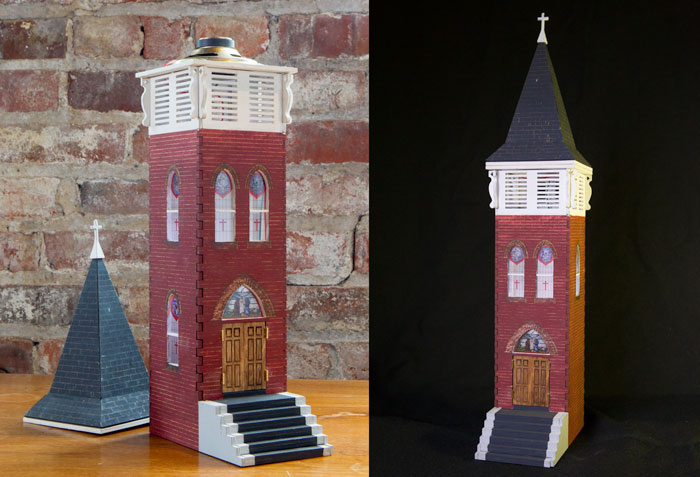
The Pi
Because the original system was built on Raspberry Pi, I could easily put it in a small case. The Raspberry Pi is small enough already, but they also offer the smaller Pi Zero form factor. Either size would have fit the case I was planning to make. I considered going with the full-sized Pi because that’s what I had worked with already and the Pi Zero doesn’t have easily accessible audio.
With the regular Pi, I would still have to come up with some amplification for the internal speakers. At the same time, Adafruit introduced the Pi Speaker Bonnet that fits nicely on a Pi Zero and uses I2S to create an audio output on Zero and amplify the source for 3W speakers. This was a perfect application for the steeple miniature and a good excuse to try out a Pi Zero. It also ended up being a cheaper option than the full-sized Pi too.
I loaded the same Node system on the Pi Zero as the system running at the church. I’m just not using the browser kiosk that shows which song is playing now, previously or upcoming in this instance. I also had to add a real time clock since the Pi would not keep present time when it is unplugged.
The Speaker Bonnet could then output to a 3W speaker that sits nicely at the top of the tower. The arrangement and use of this speaker changed somewhat, discussed later in this writeup.
The Steeple Design
I wasn’t anywhere near my grandma’s church when I decided to build a replica, so I just started making up measurements based on some pictures, videos and Google Street Views I had. I luckily also had taken photos of every stained glass window in the building for a book I put together with my grandma several years back.
This was going to be my first laser project and the material I was familiar with was various thicknesses of Baltic birch plywood. That seems to be the default on the Trotec at the Idea Foundry. I went with a 1/8” Baltic birch. Knowing that and some of the made up measurements, I began to set a scale for the model. I have no intention of including it in any sort of train set or anything but thought it would be interesting to keep it similar to an existing scale standard. I got pretty close to O-scale but had to make it a little bigger in order to fit the speaker placement I hoped to use.
I drew up the vectors in Illustrator and did some test cuts of different sizes to test out the way the sides would lock together and how the brick pattern would come out. I also tested some of my painting techniques. Not only was this my first laser project but this was really my first wood project and, besides maybe staining some baseboards, my first time painting wood carefully. I used some craft acrylic paint and slapped in on with a foam brush. I tried to brush it on quickly to give it a sort of uneven and faded look.
The Brick
I was debating how to do the brick pattern. I’m sure I had several half-cocked ideas but can’t remember all of my misconceptions. I was interested in a technique Brad was talking about where you would paint something first and then laser it down to reveal the wood underneath as sort of a negative. Or you’d paint the lasered bit and then sand the higher bit. I was trying to consider ways to get a grout and brick look when I thought I’d just laser off the red paint in the areas of the grout. This technique turned out way better than I could have imagined. Also the resolution of the laser really allowed me to go pretty small with the brick pattern. I could have even gone smaller. The etching of the brick was definitely the longest part of the lasering process.
The Roof
I’m a few years removed from trigonometry and was feeling a bit cocky after my first attempt at lasering fit perfectly. What I’m saying is I really messed up the angles when it came time to do the roof. I ended up talking trig with Will Nickley and then he just said “I can do all of this in Solidworks in a few seconds.” And he wasn’t lying.
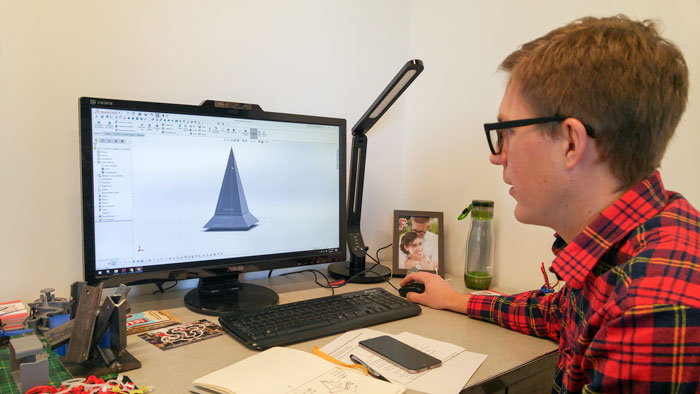
Because I’m using a laser, I couldn’t cut at any sort of angle. I spent way too much time considering the bevels of how to connect the portions of the pyramid. What I imagined was that hamster that eats miniature burritos using a mini table saw to run a 45 degree angle across all of the triangle pieces. I ended up hand sanding on a sandpaper block. It worked out okay and didn’t chip up the wood but my angles weren’t exactly 45 degrees. I relied on a lot of wood glue to just fill up those gaps. If I was mass producing this, I’d probably build a jig to run along a sandpaper block at the correct angle or even some sort of machine sander.
The Windows
There are 37 windows in the church and every one of them including the steeple attic are stained glass. The four in the attic (and represented on the top portion of the model) hadn’t even been seen by my grandma until they took her up in a cherry picker recently.
Because I already had the image files, I sent a few different sizes of the images to be printed on a transparency at a FedEx Office and picked them up on my way to my grandma’s for Christmas. I had lasered out the bottom portion of the steeple right before Christmas and wanted to show my grandma. I hated to “give” her the steeple as a Christmas present and then take it away to finish it but that’s what I had to do. When people see the steeple that’s what they seem most fascinated by and it’s funny because it’s just a $2 transparency print cut and glued on to the wood. I hope the transparency quality holds up over time.
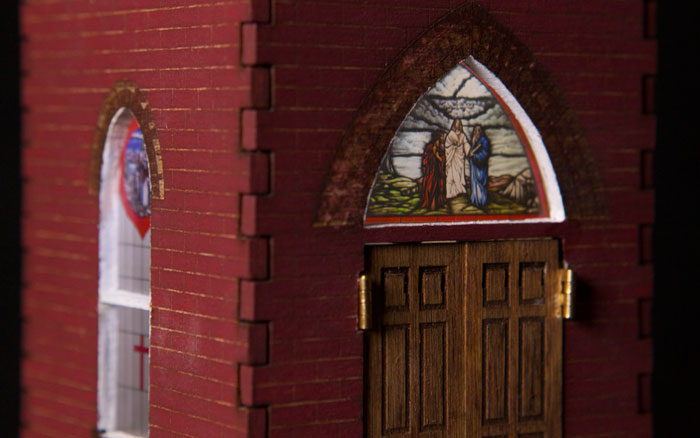
Accessing the Interior
I lasered and stained some doors and even bought little dollhouse hinges. Even though the hinges are super small they are still technically larger scale than the rest of the model but are kind of a unique touch. I had to file away at the door frame to get the hinges to fit and I really wanted to make them function as actual hinges. They came with really tiny screws that my shaky hands and patience weren’t having any luck with. I managed to glue them in but couldn’t get them to stay on both sheets of wood. I ended up settling on gluing the doors shut. I’m sure to my cousins’ kids that will look super inviting to try to open it but I wish them luck.
To access other portions of the steeple, I made the roof removable as well as what I call the rafters that support the speaker in the top. Both set into place with nested magnets. This technique was another surprise for me. It was just some stupid idea I had and it worked out alright. In reality, I don’t imagine you will need to access the top very much. The speaker is soldered and hot glued in but I left enough give in the speaker wires so that someone can remove the top and look down in at the lighting and the electronics at the bottom.
The bottom step is also removable it reveals the entire bottom panel where the Pi, clock and speaker bonnet sit and where the power comes in and the lighting and speaker wires terminate. I meant to leave enough give in the speaker and lighting wires to accordion out and let someone peek at the electronics there too but I allowed too much give at the top of the speaker wire and not enough at the bottom. I considered soldering some extra length on and may still do that in the future. For now, I’m guessing the steeple is just being admired from afar, and I’m probably the only one that’s going to be comfortable tearing into it.
This bottom step is also attached with magnets recessed into the other stairs as well as built into the lower part of the main tower portion.
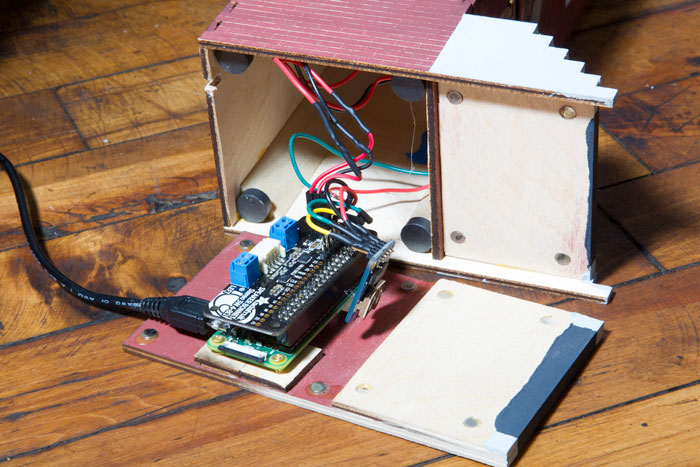
The Electronics
I mounted all of the main electronics at the base of the steeple with wires running up the insides for the speakers and LEDs.
The Speaker Bonnet
I soldered some headers on to the speaker bonnet to stack it on the Pi Zero. I also soldered some headers on to the 3V, 5V and Ground breakouts so I could easily connect different LEDs to test and to connect the RTC. I wanted to make sure the LEDs and speakers were easily disconnectable since they would be separate from the base. I ended up soldering wires directly between the clock and the bonnet since the RTC wouldn’t need to be disconnected to free the computer from the base.
The LEDs
The LED lighting delayed progress more than I’d like to admit, mainly because I really had no experience with LEDs. I had an idea for what I wanted the light to come out like. Mainly I wanted the interior to be bright enough that the detail of the windows would come out in a decently bright room. I also didn’t want the light source to be visible and wanted it to shine pretty evenly across all of the windows. I thought a more amber glow like a candle would look nice. I tried some diffused yellow-y LEDs but they were super weak. I tried some super bright white 3mm LEDs but in order to be bright they were made very directional so I didn’t get very even light. I tested some LCD backlights. They were okay but relatively dim and cumbersome. Then I used some RGB Neopixels I borrowed from Kris Kling. These were good but now I’m writing/running code to essentially shine a steady light the whole time.
I ultimately mounted two LED sequins above the window over the front door pointed toward the back wall. This lights up the interior really well. I wish it was a little warmer. I considered gelling it but at that point it was glued in and I felt like the gel might be seen through the door or windows. Plus, I think the cooler color really makes the colors in the stained glass more visible. I also considered connecting one or both of the lights to the GPIO pins and only turning them on when the chimes played. I figured my grandma would prefer to show off the windows and not have to wait until 6pm for a song to play. I considered leaving one always on and waiting to turn one on only when the chimes were playing. I was concerned this would be still too dim for the majority of the viewing and was able to leave my code the same for the full-sized version and the replica version.
The Speaker
I had kinda settled on these brass looking 3W speakers from Adafruit. My opinions kind of got the best of me because I felt like the second best option looked cheesy. It came with a convenient plug that snaps into the speaker bonnet and would have given me some more sizing flexibility. They were considerably smaller. Because I settled on the 3W speakers (a whole $1.95 a piece), I thought I was going to mount them across the top and use the steeple vents as a sort of speaker grille. I even upped the size of my original model, causing me to go outside of my O-scale plans. I ended up screwing up both. I went outside the O-scale bounds and still didn’t leave enough width to mount the speakers across the front and back or sides.
When I got the two speakers plugged in, they were plenty loud so as I was holding the 3” brass-ish speaker and trying to figure out if I was going to cut a groove that would let me force the speaker into the sides I laid it across the top and realized I could just point one speaker directly down into the tower from the roof. I really like the way it came out. It freed up the interior so that the light could sneak out the top as well. If I made this again, I’d try to stay true to the O-scale and size the steeple down a little more.
Delivering the Steeple
Though I first showed this to my grandma at Christmas, I only had the sides lasered out and the windows taped in, so I had to take it back. In March, I went back to West Virginia and was really wishing I had it all together then but instead I could only show her the roof added and the stairs stacked out. I made a point to finish it up right after that and on my way to a photo gig in State College, PA, I made a detour. I dropped it off and she got to hear them from the steeple replica for the first time.
She had a spot picked out for it after she gets done taking it to the real church and showing it to everyone there. The reports I’ve gotten so far is she and Pap both really like the glow of the lights even at night, so I’m glad I stayed with the always-on design.
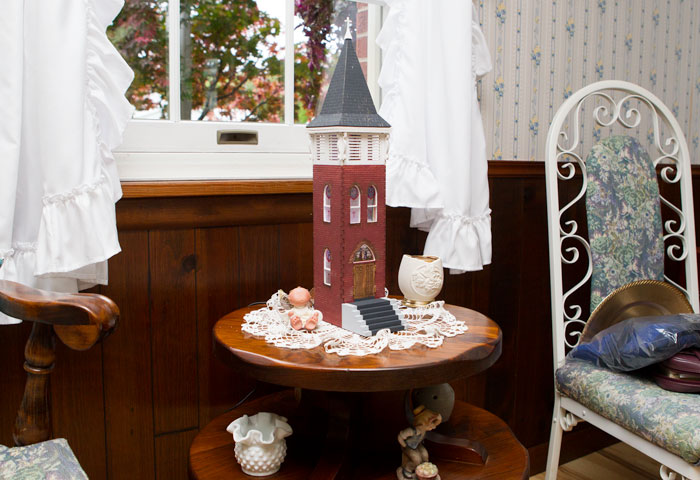
Final Toll?
I’m thinking this is it for this project. I’m eager to move on to some new ideas. I’ve considered what it would take to replicate it. I wonder if someone else wants a similar model or if I’d even want one of my own to demo with. Though I’m open to taking another crack at it, I kind of like the idea of only my grandma having one.
It was a long drawn out process, but I was learning a ton of things at the same time. I also still have the “Big Boy” chimes. They are also delivered and making sounds, but they have even more room for tweaks and improvements. I’m afraid those will never be truly done although I’m calling them “done” for now. I figure if they are in the wild and serving their purpose they can be called Done. Anything else will just be a different version number.
Tools
Technology
- Raspberry Pi Zero
- Pi Speaker Bonnet
- 3W 4Ohm speaker
- RTC
- LED sequins
- Power supply
- Trotec 400 laser
- Lulzbot 3D printer for the cross
- Node.js for server/playback program
- GarageBand and MIDI to generate the MP3 files
- Illustrator (exported to PDF and then to Corel Draw) for the laser vector files
Materials
- Magnets
- 1/8” Baltic birch plywood
- Paint
- Wire
- Heat shrink
- Glue (Goop, wood, hot)
- Dollhouse hinges
- Cute as hell mini wood clamps
